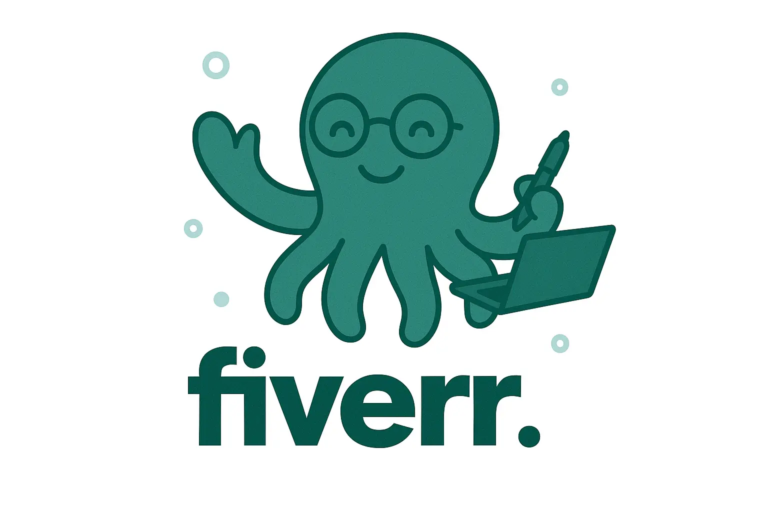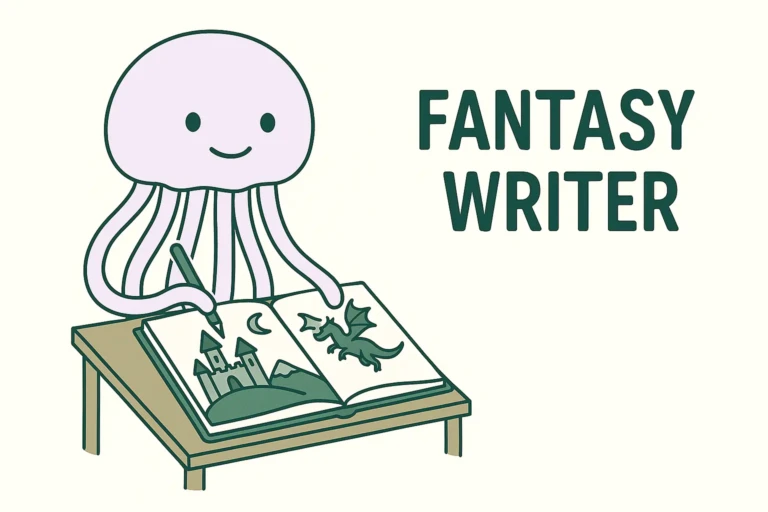10 ChatGPT Prompts For Help Desk Agent
Help desk agents juggle a lot — answering questions, calming upset users, solving tech issues, and writing follow-ups.
It’s fast-paced and stressful.
But ChatGPT can help you move faster without losing your human touch.
From writing clearer replies to suggesting solutions, the right prompts can save you time and energy.
This guide gives you 10 ready-to-use ChatGPT prompts made just for help desk agents.
They’re practical, customizable, and easy to plug into your daily workflow.
1. Responding to a Common Customer Complaint
#CONTEXT:
You’re a help desk agent responding to a customer who says their app keeps crashing during use. They’re frustrated and want a fix ASAP. You need to stay calm, show empathy, and offer next steps.
#GOAL:
Write a polite, helpful response that acknowledges the issue and offers basic troubleshooting.
#RESPONSE GUIDELINES:
Start with an empathetic opening
Acknowledge the problem clearly
Offer 2–3 simple steps to try
Suggest contacting support again if it doesn’t work
Customize with: [insert app name], [insert customer name], [insert tone preference]
#OUTPUT:
A short, friendly reply email or message.2. Troubleshooting Step-by-Step Instructions
#CONTEXT:
You’re a help desk agent guiding a customer through fixing a login issue. The user isn’t very tech-savvy, so your instructions need to be super clear and easy to follow.
#GOAL:
Provide a simple, step-by-step troubleshooting guide.
#RESPONSE GUIDELINES:
Start with a brief sentence on what the guide will help them do
Number each step clearly
Use plain language — no tech jargon
Add reminders or notes if needed (e.g., “make sure caps lock is off”)
Customize with: [insert issue], [insert software name], [insert device type]
#OUTPUT:
A numbered step-by-step guide.ChatGPT Output
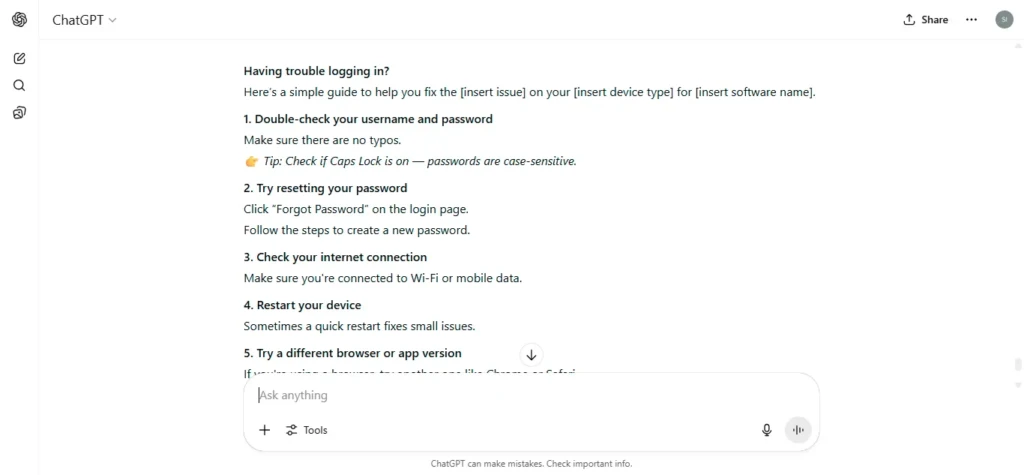
3. Writing a Professional Apology Message
#CONTEXT:
A customer experienced a long delay in receiving help. They’re disappointed and want to know why it took so long. You need to respond with a professional and sincere apology.
#GOAL:
Send a polite message that apologizes, explains briefly, and reassures the customer.
#RESPONSE GUIDELINES:
Begin with a direct and sincere apology
Acknowledge the inconvenience clearly
Briefly explain the delay (if applicable)
Reassure them it won’t happen again
Customize with: [insert customer name], [insert delay reason], [insert support team name]
#OUTPUT:
A short, professional apology email or message.4. Summarizing a Support Ticket for Handoff
#CONTEXT:
You’re handing off a support ticket to another agent or team. The issue has been partially resolved, and the next team needs a quick summary to continue the work without confusion.
#GOAL:
Write a clear, concise summary of what has happened and what still needs to be done.
#RESPONSE GUIDELINES:
Start with the customer’s main issue
List actions already taken
Mention any customer responses or updates
Highlight pending steps or unresolved parts
Customize with: [insert ticket ID], [insert product/service], [insert team name]
#OUTPUT:A support ticket summary note or message.ChatGPT Output
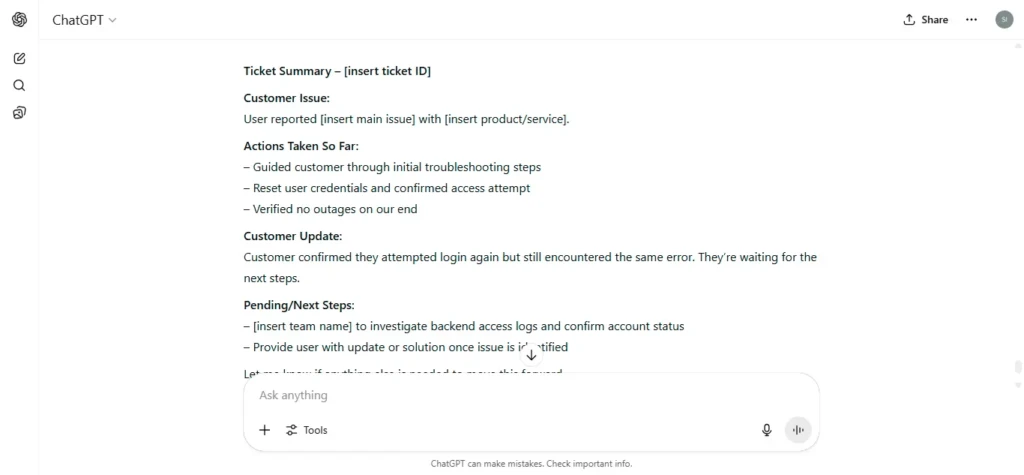
5. Asking Clarifying Questions to the Customer
#CONTEXT:
A customer has reported an issue, but their message is vague or unclear. You need more details to help them properly. Your goal is to ask clear, polite follow-up questions.
#GOAL:
Write a message that gently asks the customer for more specific information.
#RESPONSE GUIDELINES:
Thank the customer for reaching out
Briefly restate the issue as you understood it
Ask 2–3 clear follow-up questions
Encourage them to reply when they’re ready
Customize with: [insert product name], [insert issue type], [insert customer name]
#OUTPUT:
A polite and clear follow-up message.6. Creating a Knowledge Base Article Draft
#CONTEXT:
You often get repeat questions about the same issue. To save time, you want to draft a help article that answers the question clearly for future users.
#GOAL:
Create a short, clear draft of a knowledge base article to explain the solution.
#RESPONSE GUIDELINES:
Start with a short intro that explains the issue
List the steps to solve it (numbered or bulleted)
Add notes or tips where needed
Use headings or bold text for clarity
Customize with: [insert topic], [insert platform], [insert audience type]
#OUTPUT:
A clean, scannable draft article for the knowledge base.ChatGPT Output
#CONTEXT:
You often get repeat questions about the same issue. To save time, you want to draft a help article that answers the question clearly for future users.
#GOAL:
Create a short, clear draft of a knowledge base article to explain the solution.
#RESPONSE GUIDELINES:
Start with a short intro that explains the issue
List the steps to solve it (numbered or bulleted)
Add notes or tips where needed
Use headings or bold text for clarity
Customize with: [insert topic], [insert platform], [insert audience type]
#OUTPUT:
A clean, scannable draft article for the knowledge base.
7. Answering “When Will This Be Fixed?”
#CONTEXT:
A frustrated user is asking when a known issue will be resolved. The fix is underway but not done yet.
#GOAL:
Give an honest update and manage expectations.
#RESPONSE GUIDELINES:
• Be transparent about the progress
• Mention [insert issue name] or [insert ticket number]
• Reassure the user with a [insert tone] tone
• Offer to notify them once resolved
• Keep it short and sincere
#OUTPUT:
A polite progress update message.8. Following Up After Issue Resolution
#CONTEXT:
A frustrated user is asking when a known issue will be resolved. The fix is underway but not done yet.
#GOAL:
Give an honest update and manage expectations.
#RESPONSE GUIDELINES:
• Be transparent about the progress
• Mention [insert issue name] or [insert ticket number]
• Reassure the user with a [insert tone] tone
• Offer to notify them once resolved
• Keep it short and sincere
#OUTPUT:
A polite progress update message.ChatGPT Output
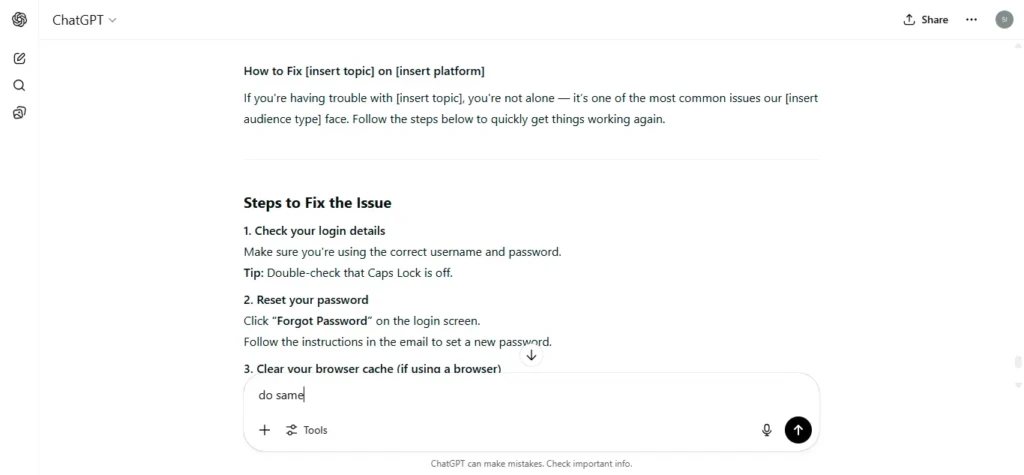
9. Translating Technical Jargon into Simple Terms
#CONTEXT:
You need to explain a technical fix or error to a non-technical customer. The goal is to keep it simple, clear, and easy to understand without sounding condescending.
#GOAL:
Turn a technical explanation into plain language anyone can understand.
#RESPONSE GUIDELINES:
Start with a clear, one-line summary of the issue
Break down the technical terms in simple words
Use real-world comparisons if helpful
Avoid acronyms or code unless necessary
Customize with: [insert error message], [insert system/tool name], [insert customer skill level]
#OUTPUT:
A clear explanation in non-technical language.10. Offering Upgrade or Solution Suggestions
#CONTEXT:
A customer is experiencing limitations with their current plan or product version. You want to suggest an upgrade or alternative solution that could improve their experience.
#GOAL:
Write a polite, helpful message that recommends a better option without sounding pushy.
#RESPONSE GUIDELINES:
Begin by acknowledging their current issue or limitation
Explain how the upgrade or alternative helps
Highlight 1–2 key benefits
Invite them to ask questions or get more info
Customize with: [insert customer name], [insert product/service], [insert upgrade option]
#OUTPUT:
A helpful recommendation message or email.How to Use These Prompts Effectively
Personalize Every Time
Replace placeholders like [insert customer name] or [insert issue] with real details
Match the tone to your company’s voice — friendly, professional, or casual
Add your own flair where needed to sound more human
Edit the AI Output
Always review the result before sending
Fix grammar, shorten long sentences, or remove anything that feels robotic
Add or tweak steps based on your actual support process
Make Prompts Part of Your Workflow
Save your favorite prompts in a shared doc or ticket system
Use them as templates for emails, chats, or internal notes
Combine prompts when needed (e.g., summarize + follow-up)
These prompts are starting points — your edits and human touch make them great.
Wrap-Up
Help desk work moves fast — and the pressure can pile up.
But with these 10 ChatGPT prompts, you’ve got a set of ready-made tools to help you reply faster, solve issues clearly, and support customers with confidence.
Whether you’re writing an apology, guiding someone through a fix, or summarizing a ticket, these prompts can save time and stress.
Start using them today. Test, tweak, and make them your own.
Your support game just got smarter.





